 Do you ever stop and notice there are things you take for granted?
Do you ever stop and notice there are things you take for granted?
Maybe something is so abundant, or it is just part of your routine, that you really don’t give it much thought.
That is, until one day, you find yourself saying “WHAT THE HECK?!”
This happened to us recently.
We were preparing a new variety of Baked Oatmeal Cups (which we are very excited about and will be on the website soon!) and we noticed that we didn’t have a coaching tip on apples.
What in the world?!
How could we not have a coaching tip on apples?!
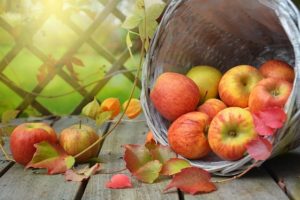 We have coaching tips that provide information on all kinds of other REAL foods, including our Superfoods of the Month series that features foods like pears, pomegranates, spaghetti squash, cauliflower, blueberries, tomatoes and so many more!
We have coaching tips that provide information on all kinds of other REAL foods, including our Superfoods of the Month series that features foods like pears, pomegranates, spaghetti squash, cauliflower, blueberries, tomatoes and so many more!
How have we gotten this far and never provided a coaching tip on apples?
Maybe it’s because apples are always around and so abundantly available all year long. Maybe we subconsciously assumed everyone already knows all about apples…would anyone really get any value from a coaching tip?
Well, here we go, we are going to give it a shot…and we want to inspire you to try different varieties of apples and enjoy them in some absolutely delicious ways! Because this is the perfect time — apples are at their peak right now and are ideal for flavor-loaded fall meals.
First of all, why eat apples?
There are SO MANY reasons!
They are convenient, portable, long-lasting, relatively inexpensive…not to mention, they are DELICIOUS AND NUTRITIOUS! Apples are loaded with both soluble and insoluble fiber (4.4 grams in a medium size apple). You may recall from our Fiberlicious! coaching tip there are numerous benefits to getting 30 grams of fiber every day, including reduced risk of cancer and cardiovascular disease. Plus, it provides good bacteria for your microbiome, helps lower cholesterol and keeps your intestines clean and healthy. In addition the fiber, apples also provide a boost of vitamin C, potassium and a variety of antioxidants. All this and just 95 calories in one small package!
Aren’t apples high in sugar?
Confession time. When we first started our REAL food journey, we tended to avoid apples because we thought they had too much sugar. What a terrible decision on our part! Like many people are today, we were confused about what foods we should be eating. Yes, a medium size apple has 19 grams of sugar, but these are natural sugars that don’t spike blood sugar the same way that added sugars can. It may seem counterintuitive, but apples have actually been shown to lower high blood sugar and reduce the risk of type-2 diabetes. What a relief…once we understood this, apples were back on the table!
Keep in mind, juice is a different story. The process to make most juices filters out the majority of the fiber and other beneficial nutrients. So, you end up with a sugar-loaded juice that affects blood sugar differently than eating an apple.
What about pesticides?
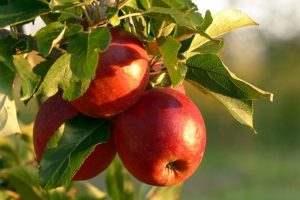 Apples are consistently on the “Dirty Dozen” list, meaning they can be relatively high in pesticide residues. If you can find a good source of organic apples this can be a great choice, especially if you can find a local grower who doesn’t use potentially harmful pesticides on their fruits.
Apples are consistently on the “Dirty Dozen” list, meaning they can be relatively high in pesticide residues. If you can find a good source of organic apples this can be a great choice, especially if you can find a local grower who doesn’t use potentially harmful pesticides on their fruits.
If neither of these are possible (or are too expensive), please don’t avoid apples! Even non-organic apples are still a better option than ultra-processed foods. Just make sure to clean them well before eating.
Tips on how to select and store apples:
- Look for any damage or discoloration to the skin. You also want to avoid any soft or mushy spots if possible. If you do get one with a soft spot, or a soft spot develops, simply cut that part off and the rest of the apple should be fine.
- The flavor and nutrients will be best shortly after they are harvested, so finding a local producer can provide real benefits vs. getting apples that have traveled thousands of miles from places like China, New Zealand or Chile.
- Of course you can enjoy them year-round, although apples are best from August to November. During the “off-season” there is a higher chance they have been imported from overseas.
- Apples store best in the crisper drawer of your fridge. Keep in mind, they can release an ethylene gas that can speed up the ripening of other produce, so you may want to store them away from other produce that tends to ripen more quickly.
How do you slow down the “browning”?
We are all familiar with the browning that happens after an apple is sliced. This happens because the apple begins to oxidize when it is exposed to oxygen. While still safe to eat, most of us prefer to avoid this unappealing brown color. There are some helpful tricks to slow down this process and keep your slices looking fresh and vibrant:
- Citric acid. Add a little lemon juice, lime juice, orange juice, or pineapple juice to prevent the browning. You can either add the juice directly to apple slices, or add the juice to a bowl of water and soak the slices in the water for a few minutes.
- Honey water. Add a couple of teaspoons of honey to 1 cup of water and soak the slices for about 30 seconds. There is a compound in honey that slows down the browning process.
- Submersion. If you submerge your apple slices in water, it will reduce the oxygen exposure. If you place a paper towel on top of the water it will help keep the apple slices in the water when they inevitably float to the top.
- Seal them up. Putting apple slices in a plastic Ziploc bag and pressing the air out will prevent the oxygen from reacting with the apple.
What about all the different varieties of apples?
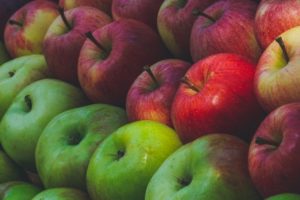 Believe it or not, there are over 2,500 varieties of apples grown in the U.S!
Believe it or not, there are over 2,500 varieties of apples grown in the U.S!
The varieties produced commercially are, not surprisingly, much fewer. Most of the U.S. production comes from Washington, New York, Michigan and Pennsylvania, although 32 states have commercial production.
While there are some slight differences in nutrition among the different varieties, most of the differences relate to the color, taste and texture. There are also some differences in how they react when exposed to heat.
As with so many things, we encourage you to try different varieties to find what you like best…also, different varieties have their own seasons, so enjoying the universe of apples when they are at their peak is a great strategy.
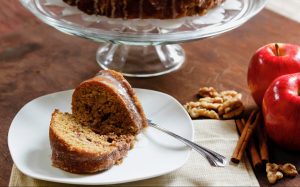 Braeburn. A sweet and crisp apple that is very versatile. Most of the U.S. production comes from Washington and the flavor tends to be more complex than some other varieties. The sweetness can mellow a bit when it is heated so it is an excellent option for both sweet and savory dishes. Try it as a topping for the Apple Walnut Pizza and the Fall Fattoush Salad.
Braeburn. A sweet and crisp apple that is very versatile. Most of the U.S. production comes from Washington and the flavor tends to be more complex than some other varieties. The sweetness can mellow a bit when it is heated so it is an excellent option for both sweet and savory dishes. Try it as a topping for the Apple Walnut Pizza and the Fall Fattoush Salad.
Empire. This variety is predominant in New York and is a cross between the Red Delicious and McIntosh. It is crisp, juicy and has a sweet-tart flavor. It doesn’t bruise as easily and it breaks down when cooked, making it a good option for applesauce, soups and apple cider. This would be a great variety for the Apple Cinnamon Bundt Cake and the Butternut Squash & Apple Soup.
Fuji. A sturdy variety with an attractive color (pink speckles over a yellow-green background). Very versatile and an ideal option for baking or roasting, perfect for the Apple Cinnamon Breakfast Quinoa or the Cinnamon Pork Chops.
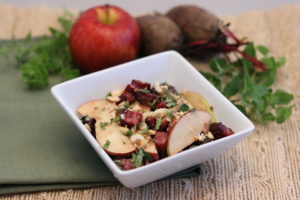 Gala. This variety has become increasingly popular, probably due to its vibrant color and flavor. It has a thin skin and juicy, mildly sweet flesh. Because it is more delicate, it is best enjoyed raw or in salads or sandwiches. It also pairs well with blue cheese, which would make it a fantastic choice for the Tangy Beet & Apple Salad and the Chopped Salad with Blue Cheese Dressing.
Gala. This variety has become increasingly popular, probably due to its vibrant color and flavor. It has a thin skin and juicy, mildly sweet flesh. Because it is more delicate, it is best enjoyed raw or in salads or sandwiches. It also pairs well with blue cheese, which would make it a fantastic choice for the Tangy Beet & Apple Salad and the Chopped Salad with Blue Cheese Dressing.
Golden Delicious. Surprisingly, this variety is NOT related to the Red Delicious. It is firm, crisp and mildly sweet. Look for a golden green color, and it is a great option for cooking and desserts. Try it in the Pork Chops with Kohlrabi Apple Slaw, the Chicken Kale Apple Salad with Pecans & Feta, the Braised Red Cabbage with Apples or the Everyday Fruit Crisp.
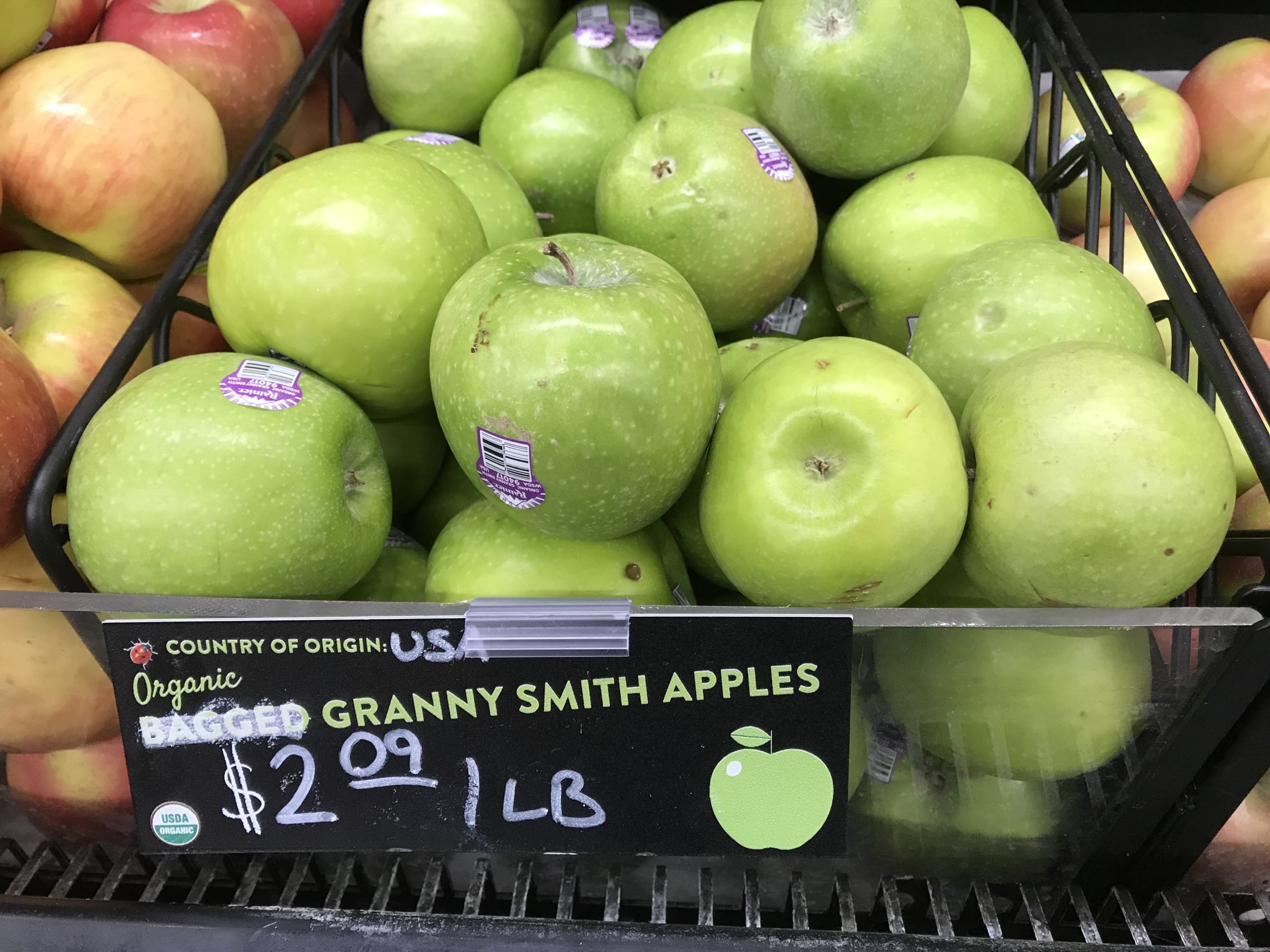 Granny Smith. This one has a distinct color and taste, is very acidic and has a tart flavor. It would be a good choice for soups and stuffings and pairs well with cheeses like gouda and brie. With their tart flavor, Granny Smith apples would compliment the Cranberry Apple Sausage Dressing or the Sausage, Apple & Onion Chicken Skillet.
Granny Smith. This one has a distinct color and taste, is very acidic and has a tart flavor. It would be a good choice for soups and stuffings and pairs well with cheeses like gouda and brie. With their tart flavor, Granny Smith apples would compliment the Cranberry Apple Sausage Dressing or the Sausage, Apple & Onion Chicken Skillet.
Honeycrisp. This is a relatively new variety that originated in Minnesota. Honeycrisp have become increasingly popular and stay sweet even when cooked, which makes them a great option for crisps, pies, salads and sandwiches. Try them in the Apple Peek-A-Boo Pancakes, the Apple Peanut Butter Quesadillas or the Overnight Cinnamon Raisin French Toast Bake.
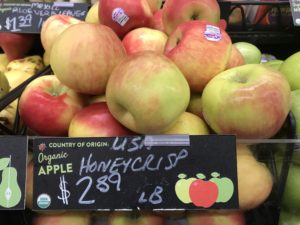 Jazz. Developed in New Zealand in the 1980s, this is a cross between the Braeburn and Gala. Dense, firm and super-crisp. Flavor-wise, Jazz apples have hints of pear, which provide a unique taste that is appealing to a lot of people. It holds up well when cooked, making it ideal for pies, tarts, soups and dishes with meats like pork or chicken. Excellent in recipes like the Pork, Apple & Sage Meatloaf, the Cabbage Apple & Pear Salad and the Baked Apples with Oatmeal Cookie Granola.
Jazz. Developed in New Zealand in the 1980s, this is a cross between the Braeburn and Gala. Dense, firm and super-crisp. Flavor-wise, Jazz apples have hints of pear, which provide a unique taste that is appealing to a lot of people. It holds up well when cooked, making it ideal for pies, tarts, soups and dishes with meats like pork or chicken. Excellent in recipes like the Pork, Apple & Sage Meatloaf, the Cabbage Apple & Pear Salad and the Baked Apples with Oatmeal Cookie Granola.
McIntosh. A popular variety that is juicy with a tangy, yet sweet, flavor. It has an attractive dark red or crimson color and it breaks down when cooked, making it a tasty ingredient for applesauce and apple cider. Perfect for the Super Cinnamon Applesauce and the Carrot Cake Overnight Oats.
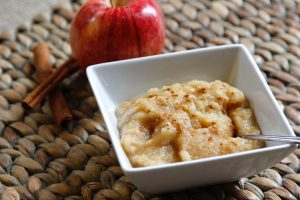 Pink Lady. You may also see this variety called Cripps Pink. It is a very attractive apple with good flavor (a tart taste with a sweet finish). The flesh oxidizes slower than some other varieties, making it a better choice for charcuterie boards, salads and sandwiches. Try this one in the Slow Cooker Autumn Pork Tacos and the Sliced Apples with Date Caramel Apple Dip.
Pink Lady. You may also see this variety called Cripps Pink. It is a very attractive apple with good flavor (a tart taste with a sweet finish). The flesh oxidizes slower than some other varieties, making it a better choice for charcuterie boards, salads and sandwiches. Try this one in the Slow Cooker Autumn Pork Tacos and the Sliced Apples with Date Caramel Apple Dip.
Red Delicious. This is the most popular variety at the grocery stores, in part because they have a tough skin and are easy to transport. They are sensitive to heat and are best enjoyed raw or in salads or sandwiches. Keep in mind, they tend to have less flavor than some of the other varieties, although they would work well in the Zesty Apple & Brussels Sprouts Salad and the Glazed Salmon Sandwich.
Do you have a favorite variety of apple?
We encourage you to try a variety you haven’t tried before (maybe even experiment with an “apple tasting” and select 3 different varieties) or simply try apples in a new and different way!
Then, please share with us!
 LEARN MORE ABOUT THE NAPKIN!
LEARN MORE ABOUT THE NAPKIN!

Leave A Comment